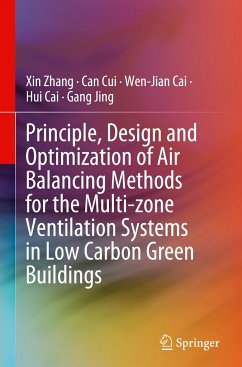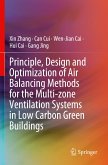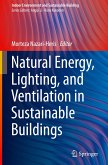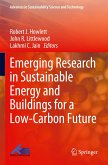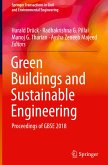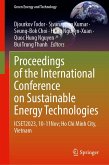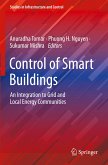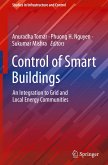Xin Zhang, Can Cui, Wen-Jian Cai
Principle, Design and Optimization of Air Balancing Methods for the Multi-zone Ventilation Systems in Low Carbon Green Buildings
Xin Zhang, Can Cui, Wen-Jian Cai
Principle, Design and Optimization of Air Balancing Methods for the Multi-zone Ventilation Systems in Low Carbon Green Buildings
- Gebundenes Buch
- Merkliste
- Auf die Merkliste
- Bewerten Bewerten
- Teilen
- Produkt teilen
- Produkterinnerung
- Produkterinnerung
This book presents a systematic study on the air balancing technologies in heating, ventilation and air conditioning (HVAC) systems. Several modern air balancing methods, including advanced control-based air balancing, data-driven-based air balancing, and energy-saving-oriented air balancing, are introduced in this book to balance the air duct system. Furthermore, this book provides clear instructions for both HVAC designers and engineers, as well as researchers, on how to design and balance duct systems for improved performance and energy efficiency.
Andere Kunden interessierten sich auch für
![Principle, Design and Optimization of Air Balancing Methods for the Multi-zone Ventilation Systems in Low Carbon Green Buildings Principle, Design and Optimization of Air Balancing Methods for the Multi-zone Ventilation Systems in Low Carbon Green Buildings]() Xin ZhangPrinciple, Design and Optimization of Air Balancing Methods for the Multi-zone Ventilation Systems in Low Carbon Green Buildings81,99 €
Xin ZhangPrinciple, Design and Optimization of Air Balancing Methods for the Multi-zone Ventilation Systems in Low Carbon Green Buildings81,99 €![Natural Energy, Lighting, and Ventilation in Sustainable Buildings Natural Energy, Lighting, and Ventilation in Sustainable Buildings]() Natural Energy, Lighting, and Ventilation in Sustainable Buildings105,99 €
Natural Energy, Lighting, and Ventilation in Sustainable Buildings105,99 €![Emerging Research in Sustainable Energy and Buildings for a Low-Carbon Future Emerging Research in Sustainable Energy and Buildings for a Low-Carbon Future]() Emerging Research in Sustainable Energy and Buildings for a Low-Carbon Future121,99 €
Emerging Research in Sustainable Energy and Buildings for a Low-Carbon Future121,99 €![Green Buildings and Sustainable Engineering Green Buildings and Sustainable Engineering]() Green Buildings and Sustainable Engineering145,99 €
Green Buildings and Sustainable Engineering145,99 €![Proceedings of the International Conference on Sustainable Energy Technologies Proceedings of the International Conference on Sustainable Energy Technologies]() Proceedings of the International Conference on Sustainable Energy Technologies226,99 €
Proceedings of the International Conference on Sustainable Energy Technologies226,99 €![Control of Smart Buildings Control of Smart Buildings]() Control of Smart Buildings145,99 €
Control of Smart Buildings145,99 €![Control of Smart Buildings Control of Smart Buildings]() Control of Smart Buildings145,99 €
Control of Smart Buildings145,99 €-
-
-
This book presents a systematic study on the air balancing technologies in heating, ventilation and air conditioning (HVAC) systems. Several modern air balancing methods, including advanced control-based air balancing, data-driven-based air balancing, and energy-saving-oriented air balancing, are introduced in this book to balance the air duct system. Furthermore, this book provides clear instructions for both HVAC designers and engineers, as well as researchers, on how to design and balance duct systems for improved performance and energy efficiency.
Produktdetails
- Produktdetails
- Verlag: Springer / Springer Nature Singapore / Springer, Berlin
- Artikelnr. des Verlages: 978-981-19-7090-0
- 1st edition 2023
- Seitenzahl: 172
- Erscheinungstermin: 19. Oktober 2022
- Englisch
- Abmessung: 241mm x 160mm x 15mm
- Gewicht: 461g
- ISBN-13: 9789811970900
- ISBN-10: 9811970904
- Artikelnr.: 65480525
- Herstellerkennzeichnung Die Herstellerinformationen sind derzeit nicht verfügbar.
- Verlag: Springer / Springer Nature Singapore / Springer, Berlin
- Artikelnr. des Verlages: 978-981-19-7090-0
- 1st edition 2023
- Seitenzahl: 172
- Erscheinungstermin: 19. Oktober 2022
- Englisch
- Abmessung: 241mm x 160mm x 15mm
- Gewicht: 461g
- ISBN-13: 9789811970900
- ISBN-10: 9811970904
- Artikelnr.: 65480525
- Herstellerkennzeichnung Die Herstellerinformationen sind derzeit nicht verfügbar.
Xin Zhang received the Ph.D. degree in Automatic Control and Systems Engineering from the University of Sheffield, U.K., in 2016 and the Ph.D. degree in Electronic and Electrical Engineering from Nanjing University of Aeronautics and Astronautics, China, in 2014. From February 2014 to December 2016, he was Research Associate with the University of Sheffield. From January 2017 to September 2017, he was Postdoctoral Research Fellow at the City University of Hong Kong. From September 2017 to August 2020, he was Assistant Professor of Power Engineering with the School of Electrical and Electronic Engineering, Nanyang Technological University, Singapore. Currently, he is Full Professor at Zhejiang University. He is generally interested in power electronics, power systems, and advanced control theory, together with their applications in various sectors. He has received the Highly Prestigious Chinese National Award for Outstanding Students Aboard in 2016. He is Associate Editor of 8 SCIjournals and transactions, such as IEEE TIE/JESTPE/OJPE Access and IET Power Electronics. Cui Can received bachelor's degree in Control Science and Engineering (Automation) from Shandong University, China, in 2014, and Ph.D. degree in Electrical and Electronic Engineering from Nanyang Technological University, Singapore, in 2019. She was Research Fellow at the Energy Research Institute @NTU from 2019 to 2020. Currently, she is Associate Professor at Ocean University of China. She is interested in advanced control, data-driven technology and the air balancing control in HVAC system. Prof Cai Wenjian is currently in the School of EEE, Nanyang Technological University, since 1999. He received his B. Eng., M. Eng., and Ph.D. from the Department of Precision Instrumentation Engineering, Department of Control Engineering, Harbin Institute of Technology, P. R. China, and Department of Electrical Engineering, Oakland University, U. S. A.,in 1980, 1983 and 1992, respectively. He has more than twenty years of industry and research experience in the areas of mechanical design, system modelling and simulation, energy and environmental system automation and process control. He participated in many industry-related research projects and published more than one hundred technical papers, three books, two patents and received three national awards. He has been often invited as a technical committee member or referee and reviewer for a number of premier conferences and journals, including Journal of Process Control, Energy and Management, etc. He is Member of IEEE. Cai Hui received the B.S.E.E. and Ph.D. degrees from Zhejiang University, Hangzhou, China, in 2002 and 2008, respectively. He is Full Professor at the College of Mechanical and Electrical Engineering of China Jiliang University, Hangzhou, China. Currently, he is Visiting Research Fellow at the School of Electrical and Electronic Engineering of Nanyang Technological University. His current research interests include power converter systems, new energy power generation, electrical parameters measurement and big data analysis, advanced control theory. Jing Gang received bachelor's degree in Electrical and Electronic Engineering from Harbin University of Science and Technology, Harbin, China, in 2000, and Ph.D. degree in Control Science and Engineering from Shandong University, Jinan, China, in 2013. Currently, he works as Lecturer at Shandong Jiaotong University. He is interested in zero energy building.
Introduction of the Air Balancing Technology.- A Hierarchical Air Balancing Method via PID Control.- A Gradient-Based Online Adaptive Air Balancing Method.- A Distributed Cooperative Control-based Air Balancing Method.- An Air Balancing Method Using Support Vector Machine.- An Air Balancing Method Using Multi-layer Feed Forward Network.- An Air Balancing Method by A Full Data-Driven Duct System Model.- An Air Balancing with Optimal Pressure Set-point for Minimized Energy Consumption.
Introduction of the Air Balancing Technology.- A Hierarchical Air Balancing Method via PID Control.- A Gradient-Based Online Adaptive Air Balancing Method.- A Distributed Cooperative Control-based Air Balancing Method.- An Air Balancing Method Using Support Vector Machine.- An Air Balancing Method Using Multi-layer Feed Forward Network.- An Air Balancing Method by A Full Data-Driven Duct System Model.- An Air Balancing with Optimal Pressure Set-point for Minimized Energy Consumption.

